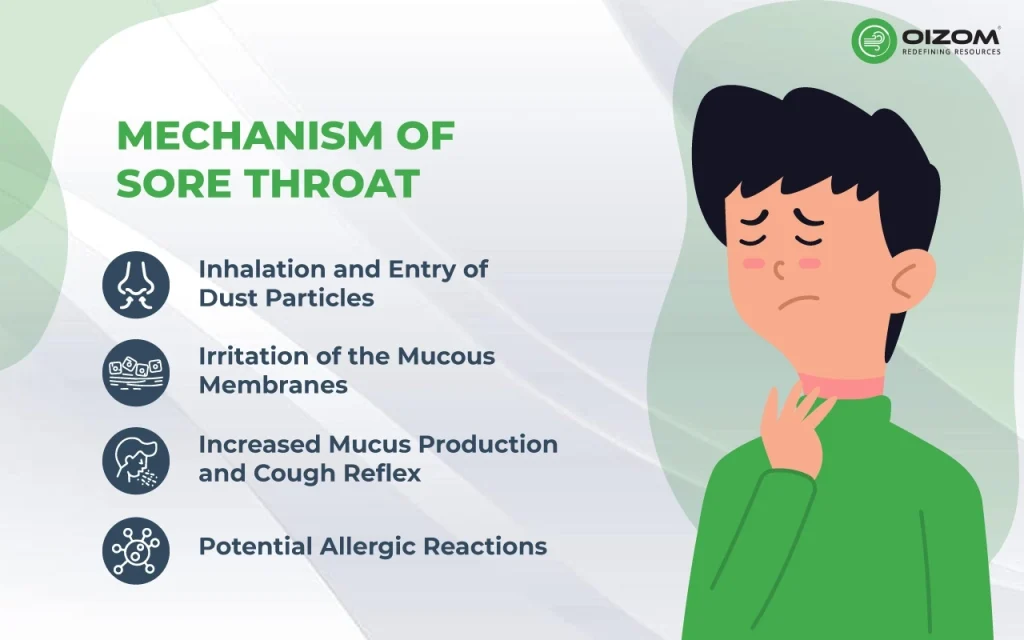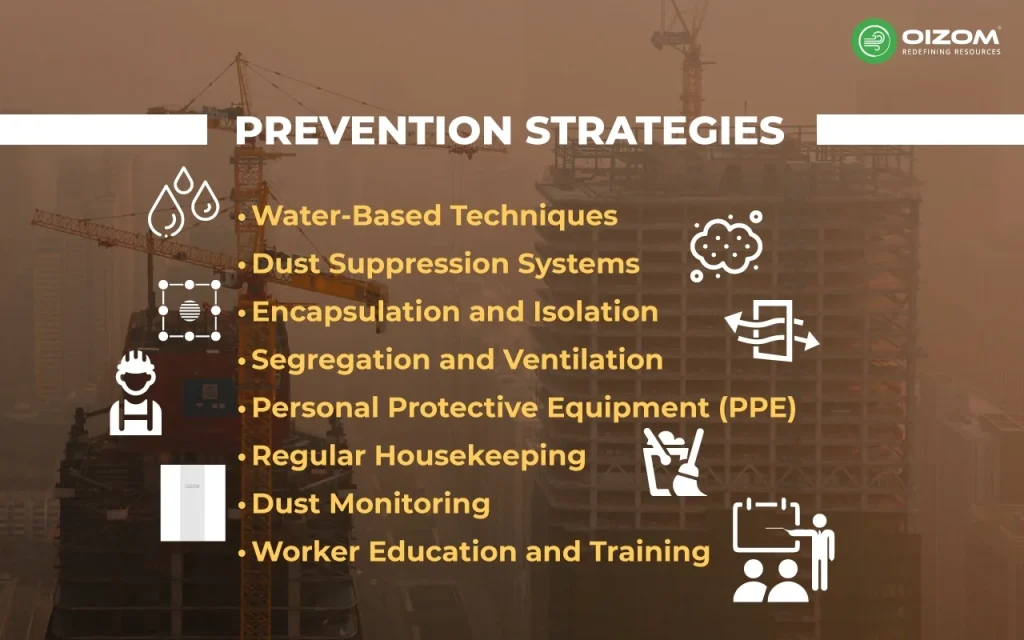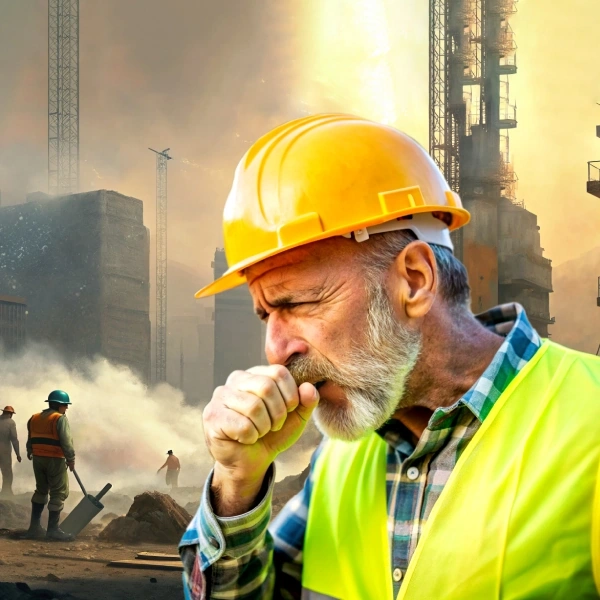Construction dust is a less visible but essential threat in the dynamic construction arena, where towering cranes dominate skylines, and the constant buzz of machinery fills the air. This delicate particulate matter, a complex mixture of components including silica, wood dust, and cement particles, frequently passes unnoticed. However, it has a significant and far-reaching impact on respiratory health. This harmful dust is more than just a byproduct of construction; it poses a severe environmental and health risk.
As environmental experts, our concern is deeply rooted in the pervasive nature of construction dust and its detrimental effects on human health and our ecosystem’s fragile equilibrium. This blog post aims to illuminate the complex nature of construction dust, its composition, its damaging effects on health, especially sore throats, and strategies for effective prevention and treatment.
Composition and Impact
Understanding the composition and impact of construction dust is vital in equipping workers and communities to safeguard their health and well-being against this hidden environmental adversary.
Construction dust, a familiar yet often underestimated hazard in the construction industry, consists of fine particles emanating from numerous construction materials. These tiny particles, frequently smaller than 10 micrometres, pose a significant threat as they can effortlessly invade the respiratory system, leading to various health complications.
The composition of construction dust is diverse, reflecting the variety of materials used in construction:
- Silica: Predominantly originating from materials like sand, stone, and concrete, silica forms a substantial portion of construction dust.
- Wood Dust: Woodworking activities such as cutting and sanding generate wood dust.
- Cement Dust: This dust type is produced during concrete mixing and pouring,
- Other Materials: Construction dust may also include particles from drywall, plaster, and asbestos, each contributing to its health risks.
Mechanism of Sore Throat

A sore throat in the context of construction dust exposure is a common yet concerning symptom that can indicate significant irritation or damage to the respiratory system. Understanding the mechanism behind this occurrence requires an examination of the interactions between construction dust particles and the delicate structures of the respiratory tract.
Depending on the duration of exposure, breathing dust-loaded air can have short- and long-term health consequences. According to the Central Pollution Control Board’s health warning, inadequate AQI can cause “breathing discomfort to most people after prolonged exposure.” While short-term exposure may lead to mild symptoms such as eye irritation and sore throat, prolonged exposure to dust particles may lead to severe conditions such as aggravated asthma.
Inhalation and Entry of Dust Particles
The process begins with the inhalation of fine dust particles. Construction sites produce many microscopic particles from silica, cement, and wood. These particles, often less than 10 micrometres, are small enough to bypass the body’s initial nasal filters and enter deeper into the throat and lungs.
Irritation of the Mucous Membranes
Once these dust particles reach the throat, they contact the mucous membranes lining the respiratory tract. These membranes are delicate and sensitive to foreign particles. The presence of dust particles on the mucous membranes triggers an inflammatory response. This response is the body’s natural defence mechanism against foreign invaders, but it can lead to irritation and swelling in the throat’s tissues.
Increased Mucus Production and Cough Reflex
In reaction to the irritation, the cells in the lining of the throat may produce more mucus. This increase in mucus is an attempt to trap and eliminate the dust particles. The body also initiates a cough reflex to expel these irritants. However, the coughing can further irritate the throat, creating a cycle of discomfort and irritation.
Potential Allergic Reactions
For some individuals, specific components of construction dust, like wood dust or certain chemicals, can trigger an allergic reaction. This reaction can exacerbate the soreness in the throat. The immune system’s response to allergens can lead to more intense inflammation, swelling, and mucus production.
Symptoms
The health impacts of construction dust exposure range from mild irritations to severe conditions, influenced by exposure duration, individual sensitivity, and pre-existing respiratory issues.
- Respiratory Irritation: Symptoms like coughing, sneezing, and sore throat are common responses to construction dust irritation. These symptoms generally subside after a short period.
- Allergies: Construction dust can provoke allergic reactions, especially in individuals sensitive to specific materials like wood or cement dust. These reactions can manifest as skin rashes, nasal congestion, and breathing difficulties.
- Asthma: For those with asthma, construction dust can aggravate symptoms, leading to increased wheezing, chest tightness, and difficulty breathing.
- Silicosis: Chronic exposure to silica dust can lead to silicosis, a debilitating lung disease characterised by scarring and inflammation. This condition compromises lung function and raises the risk of tuberculosis and lung cancer.
High-Risk Groups
Specific individuals face a heightened risk of adverse health effects from construction dust:
- Children: Due to their developing lungs, children are particularly vulnerable to the harmful impacts of dust exposure.
- Older Adults: The elderly, often dealing with chronic health issues, may experience worsened conditions due to dust exposure.
- People with Asthma: Asthmatics are at an increased risk of allergic reactions to dust, which can trigger severe asthma attacks.
- Smokers: The combined effects of smoking and construction dust exposure can exacerbate respiratory conditions and elevate the risk of developing chronic respiratory diseases.
Prevention and Treatment

In the face of the significant health risks posed by construction dust, it is imperative to adopt a comprehensive approach towards its prevention and treatment. As environmental experts, we advocate for strategies that not only mitigate exposure but also ensure the well-being of workers, placing a strong emphasis on the pivotal role of employers in this endeavour.
Prevention Strategies
The cornerstone of managing construction dust lies in effective prevention. Key strategies include:
- Water-Based Techniques: Water-based methods, such as wet cutting and demolition, help significantly reduce dust emissions.
- Dust Suppression Systems: Misters and sprinklers control dust in high-risk areas.
- Encapsulation and Isolation: Encapsulating or isolating sources of dust generation, including operations like crushing and grinding, is crucial in preventing dust dispersal.
- Segregation and Ventilation: Segregating dusty work areas and ensuring proper ventilation helps remove dust from the workplace.
- Personal Protective Equipment (PPE): Providing workers with suitable PPE, such as respirators, dust masks, and gloves, is essential in protecting them from dust inhalation.
- Regular Housekeeping: Maintaining cleanliness through regular cleaning and equipment maintenance is vital in dust management.
- Dust Monitoring: Using dust monitoring programs is vital to identify areas needing more stringent dust control measures.
- Worker Education and Training: It is fundamental to educate workers about the hazards of construction dust and train them in proper PPE usage and dust control practices.
Employer Responsibilities
Employers play a critical role in ensuring the safety of their workers:
- Dust Hazard Assessment: Conducting thorough assessments to identify and evaluate dust risks is the first step towards effective management.
- Dust Control Plan: Developing and implementing a comprehensive plan that outlines dust minimisation and control measures is imperative.
- PPE Provision: Ensuring the availability and proper use of PPE is a crucial responsibility of employers.
- Regular Housekeeping: Enforcing housekeeping practices helps maintain a dust-free work environment.
- Worker Education and Training: Continuous education and training on dust hazards and prevention are essential for worker safety.
- Health Monitoring and Surveillance: Implementing health surveillance programs helps in the early detection and management of dust-related health issues.
- Compliance with Regulations: Adhering to occupational health and safety regulations related to construction dust is employers’ legal and ethical obligation.
Conclusion
The pervasive yet often underestimated hazard of construction dust poses a considerable threat to human health and environmental integrity in the construction industry. As environmental experts, we underscore the necessity of a comprehensive and integrated approach to addressing the multifaceted challenges of construction dust. This approach hinges on three fundamental pillars: effective prevention strategies, extensive treatment options, and the critical role of employer responsibility.
Collective Action for a Safer Industry
By adopting a multi-pronged approach that prioritises prevention, supplements with treatment, and emphasises employer responsibility, we can effectively mitigate the adverse effects of construction dust. This approach goes beyond addressing immediate concerns; it lays the foundation for a safer, healthier, and more environmentally conscious construction industry. The goal of protecting the health of construction workers and preserving the quality of our environment requires concerted and collective action. It is a shared responsibility that calls for the engagement of all stakeholders in the construction ecosystem. Through collaborative efforts, we can transform the industry into a safer, more sustainable space, ensuring the health and safety of workers and protecting our environment






